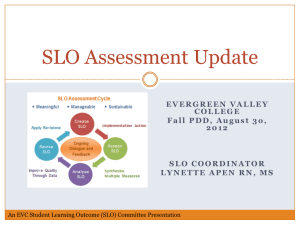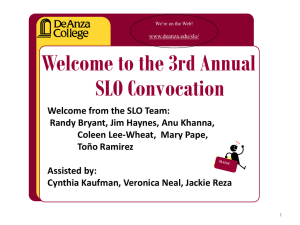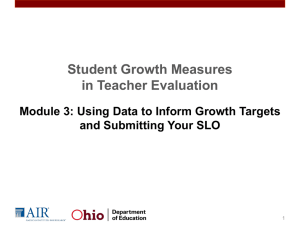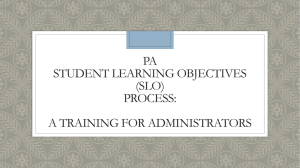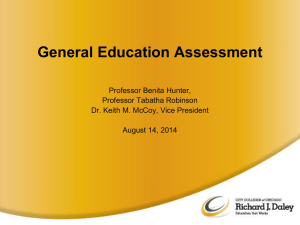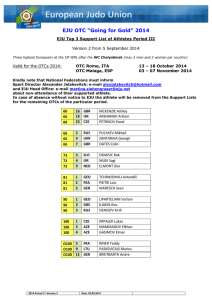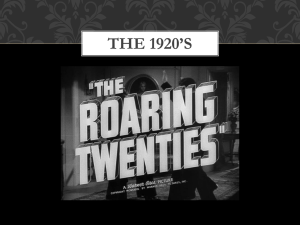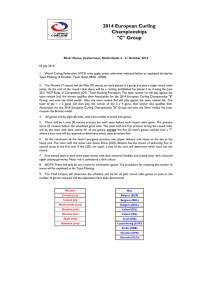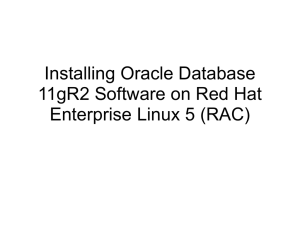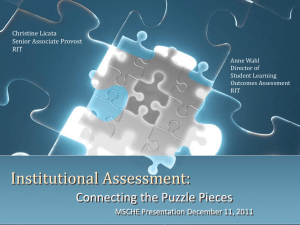Assessment for Learning - Educator Effectiveness
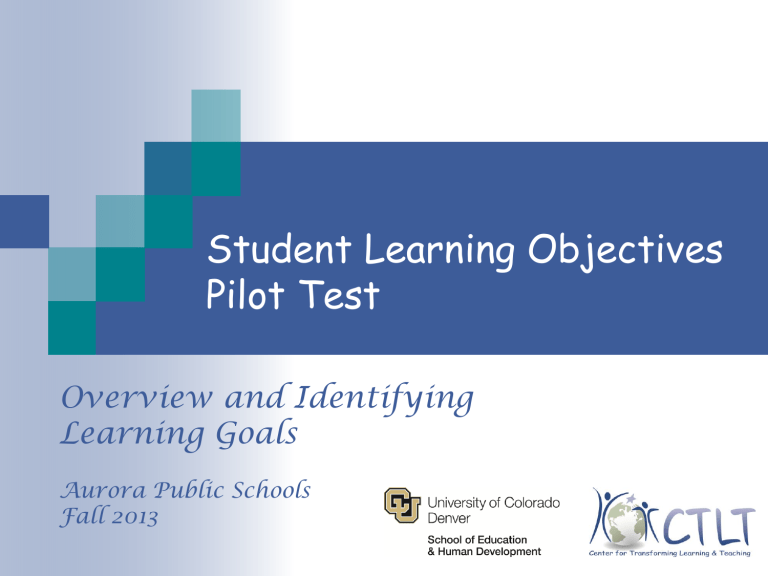
Student Learning Objectives
Pilot Test
Overview and Identifying
Learning Goals
Aurora Public Schools
Fall 2013
Introductions
Center for Transforming Learning and Teaching
Catalyzing and co-creating the transformation of learning environments through the use of assessment so that all are engaged in learning and empowered to positively contribute in a global society.
www.ctlt.org
Facilitator/Trainer:
Julie Oxenford O’Brian
Julie@ctlt.org
Coach/Trainer:
Mary Beth Romke
Mary@ctlt.org
Purpose
Introduce the major components of and context for the Student
Learning Objective (SLO) Pilot Test.
Begin to identify SLO Learning
Goals.
Introductions
Capture on a Sticky Note: One burning question you have about our work together.
Discuss at your table group
Name, role, teaching assignment
Why you agreed to participate in this pilot test.
Your question about our work together
Group share out: reasons for participating
Materials
Norms
The standards of behavior by which we agree to operate while we are engaged in learning together.
Overview Tools, p. 1
Learning Targets
Describe the purpose of Student Learning
Objectives (SLOs) as part of teacher evaluation.
Engage in learning activity during this session
Understand the purpose and major components of the student learning objective pilot test.
Complete online selfassessment
Describe the process involved in identifying an SLO Learning Goal.
Complete follow-up tasks.
Explain cognitive complexity using the Webb
Depth of Knowledge framework.
Evaluate the cognitive complexity of learning goals/objectives.
Describe and exemplify success criteria for
SLO Learning Goals.
Activity: Monitoring your learning
Turn to Progress Monitoring (Note catcher, p. 3-4)
Rewrite today’s learning targets in language that has meaning for you.
Create a bar graph which describes where you currently believe you are in relationship to each learning target .
Leave the “reflections” column blank for now.
Learning Target
I don’t know what this
Is
I need more practice
I’ve got It
I can apply it in a new way
Reflections
Describe the purpose of Student Learning Objectives (SLOs) as part of teacher evaluation.
In my words:
I know how student learning objectives will be incorporated into my evaluation.
SLO Session One Agenda
Background and Purpose of
SLOs
Purpose and
Components of
Pilot Test
SLO Template and
Process
SLO Learning
Goals
Determining
Depth of
Knowledge
Success
Criteria
Colorado State Context
SB10-191: Ensuring Quality Instruction through Educator Effectiveness
Evaluating the effectiveness of educators is crucial to improving the quality of education in Colorado.
Educators are evaluated in significant part based on the impact they have on the learning growth of their students.
SB 10-191 Teacher Evaluation Requirements
50% Professional Practices (Observational Rubric)
50% measures of teacher contribution to student learning growth:
At least one individually attributable measure.
At least one collectively attributable measure.
When available, state summative assessment results (TCAP).
When available, Colorado Growth Model results.
Other local measures (e.g. pre- post- assessment, student learning objectives).
Student Learning Objectives
One approach districts may use to develop measures of student academic growth attributable to individual educators.
Definition: A participatory method of setting measurable goals, or objectives for a specific assignment or class, in a manner aligned with the subject matter taught, and in a manner that allows for the evaluation of the baseline performance of students and the measureable gain in student performance during the course of instruction.
Teacher Evaluation Components
Student Growth
(individual attribution)
Student Growth
(collective attribution)
Professional
Practice
(observation)
Collective Attribute
Academy District 20
TCAP
Administrative/Teacher-defined assessments of individual attribution
(38% for those without an individual TCAP attribution)
Professional Practices
12%
13%
50%
25%
50%
Harrison School District
Collective Attribute District Assessment
National Assessments TCAP/MGP
Professional Practices
5%
5%
25%
15%
*Harrison has identified 97 different roles in the district. Each role’s pie chart is weighted differently. All the scales are based on the 4-5 grade core teacher shown above.
APS Individually Attributable Measures
Teacher Evaluation Revision Committee (TERC)
Members
Process
Options
Pre-Post
SLOs
Why SLOs?
Suggestion 1 from 8/27/13 TERC subcommittee meeting
Collective Attribute TCAP SLOs Rubric (Professional Practices)
30%
50%
10%
10%
Suggestion 2 from 8/27/13 TERC subcommittee meeting
Collective Attribute TCAP SLOs Rubric (Professional Practices)
10%
20%
50%
20%
Suggestion 3 from 8/27/13 TERC subcommittee meeting
Collective School/District SLOs Rubric (Professional Practices)
0%
15%
50%
35%
Suggestion 4 from 8/27/13 TERC subcommittee meeting
Collective Attribute SLOs Rubric (Professional Practices)
10%
50%
40%
Where are SLOs being used?
Districts and States across the US
Denver Public Schools
Austin
Rhode Island
New York
Georgia
Utah
Wyoming
New Hampshire
Hawaii
North Carolina
Ohio
Massachusetts
Pennsylvania
Maine
Why take an SLO approach?
Documented to:
Have high levels of credibility with educators – expectations situated directly within the classroom context and space
Be Adaptable to new assessments
Be Adaptable to all teaching assignments
Have Face validity – developed by teachers
Most qualities above are not applicable to evaluating teacher impact on student learning growth using other common approaches
What SLOs are not. . .
Simple computation of pre- and postassessment score differences
Representative of output measures
Results based on one measure/assessment instrument
An “add-on” for teachers engaged in effective teaching practices
SLO Session One Agenda
Background and Purpose of
SLOs
Purpose and
Components of
Pilot Test
SLO Template and
Process
SLO Learning
Goals
Determining
Depth of
Knowledge
Success
Criteria
Purpose of the SLO Pilot Test
Develop an approach that can be used in
Aurora to measure student learning growth that can be attributed to an individual educator.
Ensure this approach focuses educators on instructional practices that are likely to improve student learning results at the same time.
Learn from “trying it out” in real schools in APS.
Determine how to integrate SLOs with related
APS initiatives.
Build the plane while flying it!
Project Basics
Select a partner and take out the SLO Pilot Test
Overview (Overview Tools, p. 3)
Discuss these questions with your partner:
What will be the focus of this pilot test?
What does participating in the project mean to me?
What am I concerned about? (capture on sticky notes)
Integration with other Initiatives
SLOs are context dependent.
Critical outcomes of the pilot test:
Determine how SLO efforts can be integrated with other district initiatives.
Determine how SLO efforts can support and accelerate related reforms.
Ensure relevant district resources are utilized in support of SLOs.
Design
Today: Project Overview and SLO Learning Goals
Followup: Identify “candidate” SLO Learning Goals
Four additional learning sessions (in person, about four weeks apart):
Introduce/explore practices (identifying and tracking student progress towards SLOs).
De-Brief how it went “trying-out” developing SLOs and associated practices in your classroom since the last learning session.
Between Learning Sessions:
Follow-up
Try out new practices in your classroom
On-site support (local instructional leaders)
SLO Session One Agenda
Background and Purpose of
SLOs
Purpose and
Components of
Pilot Test
SLO Template and
Process
SLO Learning
Goals
Determining
Depth of
Knowledge
Success
Criteria
SLO Process
10.
Determine
Teacher
Rating
9.Analyze assessment results
8.Revise SLO if necessary
1. Identify the SLO learning goal
2. Select measures of student learning in relationship to the Learning
Goal
3. Establish performance targets using baseline data
7. Monitor student progress towards SLO
Learning Goal
6.
Implement
SLOrelated instruction
5.
Receive approval of SLO
4. Plan instruction
SLO Terminology
Take out Student Learning Objectives Terminology
(Overview Tools, p.5).
Work with a partner to answer the following questions:
How long is an “instructional interval” in the context of SLOs?
What is the difference between a “Big Idea” and a “Learning
Goal” (for an SLO)?
Is there a difference between a “learning goal” and a “learning objective”? If so, what is the difference?
What are “success criteria”? How are they related to “learning goals or objectives”?
What is the relationship between an “assessment instrument” and a “measure”?
Student Learning Objectives Form
Take out Student Learning Objectives Form (Overview
Tools, p.9)
How are Student Population and Instructional Interval determined?
SLO components:
1.
2.
3.
4.
5.
Student Learning Goal
Measures (of student learning growth in relationship to the student learning goal)
Performance Targets (for student performance groups)
Progress Monitoring
Results (student performance and teacher performance)
SLO Components
Learning Goal Learning Goal
Standards Reference
Measures
Rationale
Success Criteria
Evidence Sources
Alignment of Evidence
Performance
Targets
Progress
Monitoring
Collection and Scoring
Baseline Data
Performance Groups
Performance Targets
Rationale for Targets
Check Points
Progress Monitoring Evidence Sources
Instructional Strategies
SLO Results Student Performance Results
Targets Met
Teacher Performance
Day One
Day Two
Day Three and Four
Day Five
Activity: Exploring SLO Components
SLO Component Descriptions (Tools, p.11).
Consider the components of an SLO Learning Goal.
Independently (silently) read the first row. When you have finished reading, look at your partner and “say something”. The something could be:
A summary
A connection
A new idea
Continue until you have considered all of the components of a Student Learning Objective
Full Group considers questions. . .
SLO Session One Agenda
Background and Purpose of
SLOs
Purpose and
Components of
Pilot Test
SLO Template and
Process
SLO Learning
Goals
Determining
Depth of
Knowledge
Success
Criteria
SLO Learning Goals
A description of what students will be able to do at the end of the instructional period.
Based on the intended standards and curriculum that are being taught and learned.
Reflective of the most critical content taught and learned during the instructional interval (the Big Ideas).
Levels of Objectives
Level of Objective
Scope
Global
Broad
Educational
Moderate
Instructional
Narrow
Time needed to learn
Two or more years (often many)
Weeks, months, or academic year
Hours or days
Purpose or function
Provide vision
Design curriculum
Prepare lesson plans
Example of use Plan a multi-year curriculum (e.g., elementary reading)
Plan units of instruction
Plan daily lessons, activities, experiences and exercises
A Taxonomy for Learning, Teaching, and Assessing: A revision of Bloom’s taxonomy of educational objectives, 2001
Overview Tools, p. 1
Statements of Intended Learning
Learning Goals, Learning Objectives,
Learning Targets include:
A verb that describes a cognitive process or processes.
The content or knowledge to which the cognitive process(s) applies.
SLO Learning Goal Components
Learning Goal
Standards/Benchmarks
Rationale
Success Criteria
How SLO Learning Goal Components are
Related
SLO Learning Goal is based on:
The big ideas for the content area/grade level, and
Relevant content standards.
The Learning Goal Rationale explains why the learning goal is appropriate.
Success Criteria are guidelines, rules, or principles by which student performance is evaluated. They describe what level of performance constitutes having met the
Learning Goal.
SLO Learning Goal Process
1.
2.
3.
4.
5.
6.
7.
Identify the “big ideas” for the grade level and content area.
Identify learning goals associated with at least one “big idea” that would be achieved across several units, and/or which have related goals in prior or subsequent grade levels. These become candidates to be an SLO Learning Goal.
Determine which standards are associated with each candidate SLO
Learning Goal.
Prioritize possible Learning Goals based on the learning needs of the student population (identifying two or three top priorities).
Determine the cognitive complexity (depth of knowledge) of the priority SLO Learning Goal candidates. Eliminate candidate SLO learning goals with a depth of knowledge less than 2 for primary
(grades K-2) and less than 3 for upper elementary and secondary.
Select the SLO Learning Goal.
Describe the rationale for your selection.
Process for determining SLO Learning
Goals
Turn to the Process for Determining SLO
Learning Goals (Tools, p. 3).
Independently, review each step and make notes about your concerns regarding each step.
Discuss at your table:
How is this similar to other work in which you have engaged?
How is it different?
What concerns do you have about the process?
The “Big Ideas”
What are “big ideas”?
Declarative statements that describe concepts that transcend grade levels.
Frame or context for identifying the SLO learning goal.
Should not be the “focus” of learning goal development.
Learning Goals vs. Big Ideas
Different format:
Learning goals describe what students should know, understand and be able to do.
Big ideas are declarative statements.
Different purpose:
Big Ideas create context for learning goals.
SLO Learning Goals focus instruction and learning activity.
Resources for determining “Big Ideas”
APS Pacing Guides
CCSS ELA:
Anchor Standards
Portraits of students who are college ready
CCSS Math:
Grade Level Descriptions
Colorado Academic Standards:
Graduate Competencies
Grade Level Expectations (that cut across grade levels)
CDE Sample Curriculum Unit Overviews:
Generalizations
Your ideas?
Content Standards
Learning Goals must reference statements of intended learning from relevant standards documents.
Statements of intended learning:
Colorado Academic Standards (CAS): Evidence Outcomes
Common Core State Standards: Standard
Example:
CAS: Identify place value from ten-thousandths to millions.
Common Core State Standard: Use place value understanding to round multi-digit whole numbers to any place.
Capture the full language from the standard statement (not just a numerical reference)
Identifying a Learning Goal
(example)
Big idea: Writing from sources requires using evidence from texts to present careful analysis, well defended claims, and clear information.
Example Standards
Write arguments to support claims with clear reasons and relevant evidence:
Introduce claims, acknowledge alternative or opposing claims, and organize the reasons and evidence logically.
Support claim(s) with logical reasoning and relevant evidence, using accurate credible sources and demonstrating an understanding of the topic or text.
Use words, phrases, and clauses to create cohesion and clarify the relationships among claim(s), reasons, and evidence.
Establish and maintain a formal style.
Provide concluding statement or section that follows from and supports the argument presented.
Example Learning Goal
Students gather relevant evidence from multiple sources to make and support strong written arguments.
SLO Learning Goal Process
1.
2.
3.
4.
5.
6.
7.
Identify the “big ideas” for the grade level and content area.
Identify learning goals associated with at least one “big idea” that would be achieved across several units, and/or which have related goals in prior or subsequent grade levels. These become candidates to be the SLO Learning Goal.
Determine which standards are associated with each candidate SLO
Learning Goal.
Prioritize possible Learning Goals based on the learning needs of the student population (identifying two or three top priorities).
Determine the cognitive complexity (depth of knowledge) of the priority SLO Learning Goals. Eliminate candidate SLO learning goals with a depth of knowledge less than 3 for secondary and less than 2 for elementary.
Select the SLO Learning Goal.
Describe the rationale for your selection.
Practice Developing an SLO Learning Goal: Step one through three
Find a partner(s) who has a similar content area focus (stay with same partner(s)).
Turn to the note catcher, p. 10
Step one: Describe the “big ideas” for your focus grade level and content area.
Step two: Identify several “candidate” Learning
Goals for at least two different “big ideas”.
Step three: Identify standards associated with your big idea and candidate learning goals.
Step four: Prioritize based on learning data
Review student performance data in your content area/grade level.
Identify challenges for your student population.
Prioritize learning goals based on these areas of challenge.
Your follow-up from today. . . we won’t practice this now.
SLO Session One Agenda
Background and Purpose of
SLOs
Purpose and
Components of
Pilot Test
SLO Template and
Process
SLO Learning
Goals
Determining
Depth of
Knowledge
Success
Criteria
SLO Learning Goal Process
1.
2.
3.
4.
5.
6.
7.
Identify the “big ideas” for the grade level and content area.
Identify learning goals associated with at least one “big idea” that would be achieved across several units, and/or which have related goals in prior or subsequent grade levels. These become candidates to be the SLO Learning Goal.
Determine which standards are associated with each candidate SLO
Learning Goal.
Prioritize possible Learning Goals based on the learning needs of the student population (identifying two or three top priorities).
Determine the cognitive complexity (depth of knowledge (DOK)) of the candidate SLO Learning Goals. Eliminate candidate SLO learning goals with a depth of knowledge less than 2 for primary and less than 3 for grades 3-12.
Select the SLO Learning Goal.
Describe the rationale for your selection.
Depth of Knowledge (DOK) and SLOs
The DOK level reflected in the SLO
Learning Goal should target the DOK level reflected in the associated standards.
The DOK level reflected in the learning goal sets an expectation for how you want students to demonstrate learning.
Assessments used for SLOs will also need to target the same DOK level reflected in the learning goal.
What is cognitive rigor?
The kind and level of thinking required of students to successfully engage with and solve a task.
Ways in which students interact with content.
Focuses on complexity of content standards and assessment items or task.
“Measures the degree to which the knowledge elicited from students on assessments and performance indicators or through questioning is as complex as what students are expected to know and do as stated in the state standards.
” -
Norman Webb
57
Cognitive Rigor Models
Different states/schools/teachers use different models to describe cognitive rigor. Each addresses something different.
Bloom – What type of thinking (cognitive process) is needed to complete a task?
Webb – How deeply do you have to understand the content to successfully interact with it? How complex is the content?
Bloom ’s Taxonomy Original [1956] vs. Revised Cognitive
Dimension [2001] - Tools, p. 5
Original Revised Cognitive Dimension
Knowledge -- Define, duplicate, label, list, name, order, recognize, relate, recall
Comprehension -- Classify, describe, discuss, explain, express, identify, indicate, locate, recognize, report, review, select, translate
Remember -- Retrieve knowledge from long-term memory, recognize, recall, locate, identify
Understand -- Construct meaning, clarify, paraphrase, represent, translate, illustrate, give examples, classify, categorize, summarize, generalize, predict …
Apply -- Carry out or use a procedure in a given situation; carry out or use /apply to an unfamiliar task
Application -- Apply, choose, demonstrate, dramatize, employ, illustrate, interpret, practice, write
Analysis -- Analyze, appraise, explain calculate, categorize, compare, criticize, discriminate, examine
Synthesis -- Rearrange, assemble, collect, compose, create, design, develop, formulate, manage, write
Analyze -- Break into constituent parts, determine how parts relate
Evaluate -- Make judgments based on criteria, check, detect inconsistencies/fallacies, critique
Evaluation -- Appraise, argue, assess, choose, compare, defend, estimate, explain, judge, predict, rate, core, select, support, value
Create -- Put elements together to form a coherent whole, reorganize elements into new patterns/ structures
Explore Revised Bloom’s Taxonomy
Work with a partner to review the Cognitive
Dimension of the Revised Bloom’s Taxonomy
(Tools, p. 7).
Consider:
How is the Cognitive dimension organized?
What is the difference between different types of thinking or cognitive processes?
How do the examples clarify the taxonomy?
Identify questions for full group discussion.
Explore DOK Levels
Take out: Webb’s Depth of Knowledge
Framework Level Definitions (Tools, p. 9) and
Depth of Knowledge Levels Chart (Tools, p.11).
Work with a partner to consider:
How are DOK levels described?
What is the difference between each DOK level?
How do the examples clarify the levels?
Identify questions for full group discussion.
DOK Level 1 Examples
Locate or recall facts found in text
Apply a well-known formula
Orally read words in connected text with fluency and accuracy
State an opinion without support
Name the notes of the C Major scale
Represent math relationships in words, pictures, or symbols
Perform a simple science process or a set of procedures
DOK Level 2 Examples
Identify and summarize the major events, problem, solution, conflicts in literary text
Explain the cause-effect of historical events
Retrieve information from a table, graph, or figure and use it to solve a problem requiring multiple steps
Develop a brief text that may be limited to one paragraph
Make a puzzle or game about the topic
Create a questionnaire or survey to answer a question
Write a diary/blog entry for a character or historical figure
63
DOK Level 3 Examples
Compare consumer actions and analyze how these actions impact the environment
Analyze or evaluate the effectiveness of literary elements
Solve a multi-step problem and provide support with a mathematical explanation that justifies the answer
Write a letter to the editor after evaluating a product
Use reasoning and evidence to generate criteria for making and supporting an argument of judgment
Prepare a speech to support your perspective about global climate change
Make a booklet or brochure about a topic or an organization
64
DOK Level 4 Examples
Gather, analyze, organize, and synthesize information from multiple sources to draft a reasoned report
Analyze and explain multiple perspectives or issues with or across time periods, events, or cultures
Conduct a project that specifies a problem, identify solution paths, solve the problem, and report the results
Write and produce an original play
Critique the historical impact of policy, writings, and discoveries
Illustrate how multiple themes (historical, geographic, social) may be interrelated
Relate mathematical or scientific concepts to other content areas, other domains, or other concepts
65
Some things to consider. . .
Extended time alone is not the distinguishing factor for a learning goal with a DOK Level 4.
DOK is not hierarchical.
DOK and Bloom ’s Taxonomy are different - the
DOK Level is NOT determined by the verb, but rather the context in which the verb is used and the depth of thinking required.
DOK is about complexity —not difficulty!
The intended student learning outcome determines the DOK level.
What mental processing must occur?
While verbs may appear to point to a DOK level, it is what comes after the verb that is the best indicator of the rigor/DOK level.
DOK 1 Describe three characteristics of metamorphic rocks.
(Simple recall)
DOK 2 Describe the difference between metamorphic and igneous rocks. (Requires cognitive processing to determine the differences in the two rock types)
DOK 3 Describe a model that you might use to represent the relationships that exist within the rock cycle. Provide evidence to support your decision. (Requires deep understanding of the rock cycle and a determination of how best to represent it by providing evidence)
67
Combining Blooms and DOK
Cognitive Rigor Matrix combines Blooms Revised
Taxonomy and Depth of Knowledge in one table.
Not a crosswalk between these two classification tools.
Not to be used as a rubric.
Available in a variety of content areas:
English Language Arts
Social Studies
Math
Science
Writing
The Cognitive Rigor Matrix:
Applies Webb ’s DOK to Bloom Cognitive Process Dimensions
Depth + thinking
Level 1
Recall &
Reproduction
Level 2
Skills &
Concepts
Level 3
Strategic
Thinking/
Reasoning
Level 4
Extended
Thinking
Remember - Recall, locate basic facts, details, events
Understand
Apply
Analyze
- Select appropriate words to use when intended meaning is clearly evident
- Use language structure (pre/suffix) or word relationships
(synonym/antonym) to determine meaning
- Identify whether information is contained in a graph, table, etc.
- Specify, explain relationships
- summarize
– identify main ideas
– Use context to identify meaning of word
- Obtain and interpret information using text features
– Compare literary elements, terms, facts, events
– analyze format, organization, & text structures
- Explain, generalize, or connect ideas using supporting evidence
(quote, example…)
- Explain how concepts or ideas specifically relate to other content domains or concepts
- Use concepts to solve non-routine problems
- Devise an approach among many alternatives to research a novel problem
- Analyze or interpret author ’ s craft (literary devices, viewpoint, or potential bias) to critique a text
– Analyze multiple sources
- Analyze complex/abstract themes
Evaluate
Create - Brainstorm ideas about a topic
- Generate conjectures based on observations or prior knowledge
– Cite evidence and develop a logical argument for conjectures
- Synthesize information within one source or text
- Evaluate relevancy, accuracy, & completeness of information
- Synthesize information across multiple sources or texts
Cognitive Rigor Matrices
Considering both classification systems together, deepens understanding of learning goals.
Examples:
English Language Arts and Social Studies
(Tools, p. 13)
Math and Science (Tools, p. 15)
Writing (Tools p. 17)
Select one to explore further.
Definition of “deconstructing”
When we deconstruct a statement of intended learning, we break it into its component parts.
Stiggins, 2004
Deconstructing means to determine…
What students need to know - the knowledge, concepts or content?
In what cognitive processes students need to engage?
© CTLT 2008
We deconstruct to…
Clarify the type of thinking (or skills) required of learners to meet the learning goal;
Determine what knowledge students will require to meet the learning goal; and
Classify the cognitive rigor of the learning goal.
How to deconstruct
Think of the verbs in our learning goal as the cognitive processes and/or types of thinking that are being required.
Think of the nouns in our learning goal as clues to the knowledge (concepts or content).
Use Bloom’s Taxonomy and Webb’s DOK framework to classify the rigor of the learning goal.
How to Deconstruct
1. Circle the cognitive processes or skills — the verbs.
2. Underline the key concepts or knowledge —the important nouns and noun phrases.
3.
Use the Cognitive Rigor Matrix to:
Characterize the type of thinking based on
Revised Bloom’s Taxonomy.
Assign a DOK level.
Example
Deconstruct the instructional objective:
Recognize that different forms of writing have different patterns of organization.
Cognitive Process (Blooms): Remember
Depth of Knowledge Level: One
Practice
Turn to Deconstruction Practice (note catcher, p. 14).
Work with a partner to deconstruct and categorize the example instructional objectives.
Share your ideas with the full group.
Applied to your Learning Goals
Go back to your candidate learning goals.
Deconstruct them identifying the cognitive process (Blooms) and Depth of Knowledge, capture in your note catcher.
What is the cognitive rigor of your candidate learning goals?
A good SLO learning goal is cognitively complex (as measured by Depth of Knowledge) with a DOK >= 3 for secondary and upper elementary and a DOK >= 2 for primary (K-2).
Have you identified an SLO learning goal with sufficient cognitive rigor?
Deconstructing
A tool for your “toolkit.”
Used to get at the meaning of statements of intended learning:
Used in determining the cognitive rigor of SLO
Learning Goals.
Collaborative process used to determine meaning of learning objectives (including grade level expectations and evidence outcomes).
First step towards ensuring accuracy in assessment.
Used in the process of critiquing/selecting assessment items.
SLO Session One Agenda
Background and Purpose of
SLOs
Purpose and
Components of
Pilot Test
SLO Template and
Process
SLO Learning
Goals
Determining
Depth of
Knowledge
Success
Criteria
Success Criteria
Guidelines, rules, or principles by which student responses, products or performances are evaluated. They describe what to look for in student products or performances to judge quality. They are also used to determine if the learning goal(s)/target(s) was/were met.
Success Criteria
We use success criteria to:
Define student competency, mastery, performance, knowledge on tasks, assessments, courses, etc.
We also need to use success criteria to:
Help define and justify what each performance level means on the SLO learning goal.
How good is “good enough”?
Talk to your neighbor about. . .
What evidence do teachers use to decide students are learning?
How have we traditionally answered that question?
Why is this question important?
Why is it important for students to understand how good is good enough?
What is good enough (traditionally)?
Behavior:
Attendance
Participation
Compliance
Grades:
In terms of the learning, what is the difference in learning between an F and A, between B+ and A- ?
Percentages:
In terms of the learning, what is the difference between 89 and 90?
In a standards-based system
Success Criteria:
Define the nature of quality, how good is good enough as the basis for judging student learning progress.
Define levels of performance on the SLO
Learning Goals and instructional level targets.
May also be called:
Proficiency Descriptions
Performance Criteria
Background Reading Discussion
Work with a partner.
Each partner reads one of the following:
Clarke (2001) Developing a “learning culture” in the school (Toolkit, p. 21).
Moss & Brookhart (2009). What does it mean to share learning targets and criteria for success? (Toolkit, p.
23).
Discuss:
What are success criteria/performance criteria/ proficiency descriptors?
Why is it important to identify success criteria?
What are good success criteria?
Success Criteria. . .
Reflect what “quality is” in the product, performance, or task.
Do not. . .
Leave important things out
Include the trivial (e.g. neatness)
Video: Student Benefits
John McKinney , Grade 8, Science
What did you hear students say about the benefits of success criteria, or knowing what proficiency looks like?
Rubrics
A tool for:
Clarifying instructional goals (for teachers).
Communicating success criteria (to students).
Scoring assignments and assessments.
Includes descriptions of more than one level of performance.
More on rubrics later today.
Posting Exemplars
Engaging Learners in Describing
Success Criteria
Hearing the learner perspective
Video: Emily’s Story
Take a few minutes to read Emily’s papers
(Tools, p. 35).
Take notes as you watch the video:
How were learners involved in defining and interpreting success criteria?
How did this enhance student motivation and learning?
Stiggins, R. J., Arter, J. A., Chappuis, J., & Chappuis, S. (2004).
Classroom assessment for student learning: Doing it right – using it well.
Commonly used methods of sharing success criteria with students include:
1.
Provide students with lists of attributes.
2.
3.
4.
5.
6.
7.
Provide students with a scoring guide or rubric.
Provide examples of work that demonstrates mastery and engage students in determining why the work demonstrates mastery.
Share work that does not demonstrate mastery with students and have them describe what it would take for the work to demonstrate mastery.
Facilitate student evaluation of different work examples using rubrics or scoring guides.
Facilitate student development of rubrics or scoring guides after analyzing examples of work.
Other?
(Tools, p. 39)
Success Criteria Teacher Considerations for the SLO learning goal
What performance label would you use to describe student success on (having met) the SLO learning goal?
What expectations do you have to define “success” on the learning goal?
Which assessments, tasks, or data sources would give you the best information about student performance on the learning goal?
How would you weigh the body of evidence collected about student performance on the learning goal?
Taking it into practice
Practice developing an SLO Learning Goal:
Identify candidate SLO Learning Goals (starting with “big ideas”).
Specify associated standards.
Determine which represent learning needs for your students.
Determine the cognitive complexity of the candidate SLO Learning
Goals.
Select one, write as an “objective statement”.
Describe success criteria for your SLO Learning Goal.
Practice engaging learners with success criteria.
Bring a draft SLO Learning Goal (note catcher) and artifacts from your experience engaging learners in understanding success criteria to our next in-person learning session.
Give us Feedback!!
Written: Use sticky notes
+ the aspects of this session that you liked or worked for you.
The things you will change in your practice or that you would change about this session.
? Question that you still have about the topics we addressed today.
Ideas, ah-has, innovations
Oral: Share out one ah ha!
References
Anderson, L.W., Krathwohl, D.R., Eds. (2001). A Taxonomy for Learning Teaching and
Assessing: A Revision of Bloom's Taxonomy of Educational Objectives . New York, NY:
Addison Wesley Longman, Inc.
Bloom, B. (1984). The search for methods of group instruction as effective as on to one tutoring. Educational Leadership, 41(8): 4-17.
Bransford, J, Brown, A & Cocking, R. (Eds). (1999). How People Learn: Brain, Mind,
Experience, and School.
Washington DC: National Academy Press
Hess, K., Carlock, D., Jones, B., & Walkup, J. (2011). What exactly do “fewer, clearer, and higher standards ” really look like in the classroom? Using a cognitive rigor matrix to analyze curriculum, plan lessons, and implement assessments. National Center for the
Improvement of Educational Assessment, Accessed on-line at: http://www.nciea.org/publication_PDFs/cognitiverigorpaper_KH12.pdf
Stiggins, R. J., Arter, J. A., Chappuis, J., & Chappuis, S. (2004). Classroom assessment for student learning: Doing it right – using it well.
Webb, N. L. (1997).
Criteria for alignment of expectations and assessments in mathematics and science education . Council of Chief State School Officers and National Institute for
Science Education Research Monograph No. 6. Madison, WI: University of Wisconsin.
